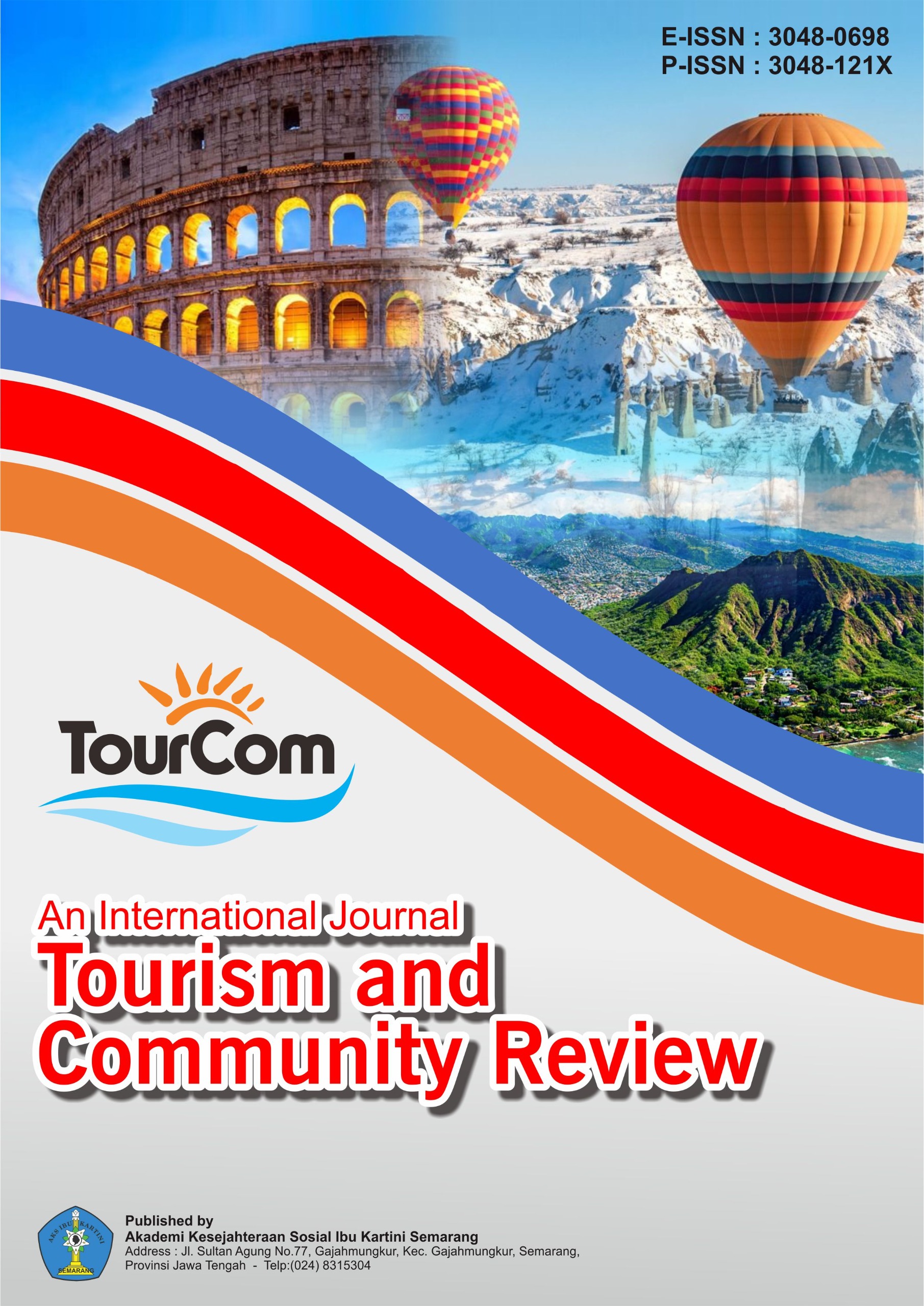Visitor Growth Strategies: Evaluating the Effectiveness of Tourism Marketing at Kebun Raya Mangrove Surabaya
DOI:
https://doi.org/10.69697/tourcom.v2i2.281Keywords:
Ecotourism, Mangrove, Marketing Strategy, Tourism, Visitor GrowthAbstract
Kebun Raya Mangrove (KRM) Surabaya is the first thematic botanical garden in Indonesia that focuses specifically on the mangrove ecosystem. It serves multiple functions, including conservation, education, research, and recreation. With its ecological uniqueness, KRM has strong potential to develop into a prominent ecotourism destination. However, post-pandemic conditions have seen a significant decline in visitor numbers, indicating the urgent need for more effective and targeted marketing strategies. This study aims to identify and evaluate marketing strategies that can enhance tourist interest and increase visitation to KRM Surabaya. The research adopts a descriptive method with a qualitative approach by collecting both primary data (through observations and interviews) and secondary data, which are then analyzed thematically. The findings indicate that KRM is currently facing several critical challenges, including limited accessibility, inadequate digital promotion, and environmental maintenance issues. Existing marketing efforts—such as affordable ticket pricing, minimal promotion via the official social media accounts of the Food Security and Agriculture Service, and limited collaboration with local SMEs—have not successfully expanded KRM’s market reach or visibility. To address these gaps, the study recommends a comprehensive marketing strategy that includes the optimization of digital marketing through official KRM-managed social media channels, strategic partnerships with ecotourism influencers, the organization of thematic events (e.g., mangrove festivals), and the innovation of mangrove-based products that can boost local identity and visitor engagement. By implementing these strategies, KRM is expected to strengthen its destination branding, attract a broader audience, and establish itself as a leading model for sustainable tourism in Surabaya and beyond.
References
Andini, Melly, Marekas, Lily Ivana, Mutiarani, Dhita, Wardani, Ega, Gustina, Siska, & Yuliana. (2022). Analysis of the Potential and Attraction of Way Tebabeng Park Tourism in Jagang Village. Community Service Cendekia, 1 (2), 54–63. https://doi.org/10.47637/pkmcendekia.v1i2.483
Daniel Harvey, Rengkung, Michael M., & Rate, Johannes Van. (2020). Marine Tourism Object Development Strategy in Lirung District, Talaud Islands Regency. Sabua: Journal of Built Environment and Architecture, 9 (2), 125–132.
Department of Food Security and Agriculture. (2023). KRM Development Reflection book 2022 (history)[1].pdf.
Fadilla, H. (2024). Tourism Sector Development to Increase Regional Income in Indonesia. Benefit: Journal of Bussiness, Economics, and Finance, 2 (1), 36–43. https://doi.org/10.37985/benefit.v2i1.375
Haque-fawzi, Marissa, Iskandar, Ahmad Syarief, Erlangga, Heri, Nurjaya, & Sumarsi, Denok. (2022). MARKETING STRATEGY Concept, Theory and Implementation. In Pascal Books. Retrieved from http://repository.ibs.ac.id/id/eprint/4973
Introduction to Tourism. Retrieved from https://search.app/5K3zF4QHmnLmpmFH8
Ismayanti. (2020). Basics of Tourism (An Introduction). Retrieved from http://repository.usahid.ac.id/322/1/Draf Buku Dasar-dasar Pariwisata - Ismayanti %281%29.pdf
KEMENPAREKRAF. (2024). Outlook for Tourism and Creative Economy. In Deputy for Strategic Policy, Ministry of Tourism and Creative Economy/Tourism and Creative Economy Agency of the Republic of Indonesia Jakarta – Indonesia. https://bankdata.kemenparekraf.go.id/upload/document_satker/a6d2d69c8056a29657be2b5ac3107797.pdf
Pahlevi, Andreas Syah, & Fadlurrahman, Muhammad Arif. (2024). Application of the RACE Model to the Promotional Media of the Green Leaf Mangrove Ecotourism of Bawean Island as an Effort to Integrate Digital Marketing. Journal of Visual Communication Design Asia, 8 (02), 17–26. https://doi.org/10.32815/jeskovsia.v8i02.1031
Pandaleke, CJ, & Mananeke, L. (2019). Factors Affecting the Level of Tourist Visits in Southeast Minahasa Regency. Journal of Economic, Management, Business, and Accounting Research, 7 (4), 5476–5484.
Parhusip, Nancy Boru, Buwono, Sri, & Anasi, Putri Tipa. (2023). ANALYSIS OF THE POTENTIAL OF MANGROVE TOURISM OBJECTS IN THE KUPAH RIVER, SUNGAI KAKAP DISTRICT, KUBU RAYA REGENCY. 12, 2413–2422. https://doi.org/10.26418/jppk.v12i9.69653
Pinontoan, Nexen Alexandre, Wihardi, Doddy, Lestari, Rini, & Kristanty, Shinta. (2024). Tourism Marketing Strategy in Promoting Angke Kapuk Mangrove Nature Tourism Park as an Ecotourism Destination. Scientific Journal of Social Dynamics, 8 (1), 52–58. https://doi.org/10.38043/jids.v8i1.4907
Rinaldi, Afdhol. (2023). Marketing Mix Strategy Analysis to Increase Sales at D'Besto Fried Chicken Pekanbaru. JAWI: Journal of Ahkam Wa Iqtishad, 1 (4), 185–191. Retrieved from https://naaspublishing.com/index.php/jawi/article/view/77%0Ahttps://naaspublishing.com/index.php/jawi/article/download/77/49
Saputra, Kadek Surya Adi, Putera, Wayan Andrika, & Dewi, Ni Putu Jois Tika. (2024). Improving the Experience of Prospective Tourists with Augmented Reality Applications in the Ngurah Rai Bali Mangrove Forest Park using the RAD (Rapid Application Development) Method. (December). https://doi.org/10.35746/jtim.v6i3.595
Sudirman, Indrianty, & Musa, Muhammad Ichwan. (2011). Marketing Strategy. In Scientific Papers on Economics (Vol. 14).
Downloads
Published
How to Cite
Issue
Section
License
Copyright (c) 2025 An International Journal Tourism and Community Review

This work is licensed under a Creative Commons Attribution-ShareAlike 4.0 International License.





